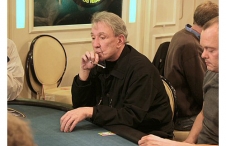Al Freeman
The 1950s and 1960s were the halcyon days of Las Vegas hotel publicists. Throughout those two decades, men like Herb McDonald, Harvey Diederich, Jim Seagrave, Eugene Murphy, and Abe Schiller successfully promoted Las Vegas. Al Freeman, who worked at the Sands Hotel from its opening in 1952 until his death twenty years later, was one of the most gifted of these publicists.
Born in 1924, Freeman was a much decorated veteran of World War II. After obtaining a degree in marketing and journalism from Temple University he worked briefly for the Philadelphia Inquirer and an advertising agency before joining the George Evans Associates public relations firm, which handled stars like Frank Sinatra, Jerry Lewis, and Dean Martin.
Because he had worked with Jack Entratter of the famed New York Copacabana, Freeman joined Entratter when the latter moved to Las Vegas in 1952 as entertainment director and one of the owners of the new Sands Hotel. From the opening night, Freeman was instrumental in making the hotel the leading entertainment center and resort along the famed Las Vegas Strip. Like other successful publicists, Freeman developed good relationships with entertainment columnists and travel agents and often collaborated with the Las Vegas News Bureau on stories and photos promoting the Sands.
What set Freeman apart from the other publicists was his skillful promotion of the Sands in movies and on television. While some publicists worked with production companies reluctantly because of the disruption that making movies and television programs caused guests, Freeman embraced the opportunities as long as the program or movie portrayed the Sands and Las Vegas in a positive way. In addition to variety shows like those hosted by Milton Berle and Red Skelton, Freeman worked closely with producers of several television series including Make Room for Daddy with Danny Thomas, The Millionaire, I Spy, and Julia. He also helped arrange the filming of major motion pictures like Meet Me in Las Vegas in 1955 and Ocean's Eleven five years later. He felt that movies and programs like these, which reached very large audiences, were helpful in promoting the Sands as an exciting and family-oriented resort. He even arranged for the Post cereal company to shoot eight commercials at the Sands, featuring the television family of Danny Thomas. He did not neglect radio. In 1955, he arranged for the very popular Breakfast with Dorothy and Dick, a program featuring Richard Kollmar and his wife Dorothy Kilgallen, which originated on WOR in New York, to be broadcast for a few days from the Sands.
Freeman's greatest impact came from his "stunts." All publicists had success with humorous, eye-catching photos usually featuring "cheesecake" shots of showgirls, but Freeman set the standard for creativity. Three stand out. In 1953, he arranged one of the most publicized weddings of the decade. When popular crooner Dick Haymes announced plans to marry actress Rita Hayworth, Freeman persuaded them to have the ceremony at the Sands, where he carefully scripted all aspects of the ceremony, which had more journalists present than family members. With all the lights and cameras in the room, one reporter said it looked like a movie set. The Time magazine article on the event proclaimed, "Never in Hollywood history had there been such a sample of matrimony-by-pressagent." Most importantly for Freeman, the article mentioned the Sands Hotel six times.
Another "stunt" developed in the context of the atomic tests that occurred only sixty-five miles from Las Vegas in the 1950s. Like other publicists, Freeman took advantage of the remarkable press coverage of the tests. Noted journalists like Bob Considine, Walter Cronkite, Lowell Thomas, John Cameron Swayze, and Dave Garroway covered several of the tests, and Freeman was able to book many of them at the Sands. He then proclaimed his hotel as the "official press headquarters" for the tests. He even persuaded the Federal Civil Defense Administrator to name him a Consultant on Public Relations to the Civil Defense Administration.
Finally, Freeman came up with the most memorable image of Las Vegas in the 1950s. Working closely with Las Vegas News Bureau photographer Don English, Freeman decided to have a real craps table placed in the Sands pool and have a photo taken with players standing around the table in swim suits. In a takeoff of the running gag in the popular play Guys and Dolls, the caption for the photo, with the Sands sign prominently in the background, read "floating crap game."
Freeman's untimely death in 1972 at age forty-eight cut short a remarkable career, one that catapulted the Sands Hotel to the forefront of Las Vegas resorts.


